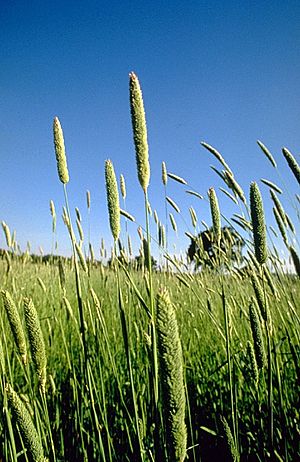Phalaris (plant) facts for kids
Quick facts for kids Phalaris (plant) |
|
|---|---|
 |
|
| Phalaris aquatica | |
| Scientific classification |
|
| Kingdom: | Plantae |
| Clade: | Tracheophytes |
| Clade: | Angiosperms |
| Clade: | Monocots |
| Clade: | Commelinids |
| Order: | Poales |
| Family: | Poaceae |
| Clade: | BOP clade |
| Subfamily: | Pooideae |
| Tribe: | Poeae |
| Subtribe: | Phalaridinae Fr. |
| Genus: | Phalaris L. |
| Species | |
|
15-22 species (see text) |
|
Phalaris is a type of grass found all over the world, except in Antarctica. These grasses can grow in many different places, from very wet areas like marshes to dry spots, and from low lands to high mountains. Some kinds, like P. arundinacea and P. aquatica, can even spread quickly and take over wet areas.
Contents
What are Phalaris Grasses?
Phalaris is a group of grasses that includes about 15 to 22 different species. They are known for their unique seed heads, which often look like small, dense spikes. These grasses are part of the larger Poaceae family, which is the scientific name for grasses.
Natural Chemicals in Phalaris
Some Phalaris grasses contain natural chemicals called alkaloids. These chemicals can be harmful to animals, especially sheep and cattle. When animals eat too much of these grasses, the chemicals can make them sick. It can cause problems with their brain and other body parts, sometimes even leading to serious illness or death.
How Phalaris Affects Animals
Certain types of Phalaris grasses, such as Phalaris arundinacea, Phalaris aquatica, and Phalaris brachystachys, have more of these harmful chemicals. Farmers try to avoid planting these types where their sheep and cattle graze.
The amount of these chemicals in the grass can change. For example, there are more chemicals in the autumn or during dry weather. Also, if the grass is cut or eaten and then grows back, the new growth often has more of these chemicals.
In 2018, wild kangaroos in Australia were seen getting sick from eating Phalaris grass. They would get "phalaris staggers," which made their heads shake and caused them to lose their balance and fall over.
Farmers can help protect their livestock by giving them cobalt or spraying it on the fields. Cobalt helps animals fight off the effects of the chemicals. However, wild kangaroos do not get this treatment, so they can get very sick. This problem is worse in areas with limestone soils, which have less cobalt than basalt soils.
| Species |
|
|
|
|
| Phalaris aquatica |
|
|
|
|
| Phalaris arundinacea |
|
|||
| Phalaris brachystachys |
|
|
Some Phalaris species, like P. californica, P. canariensis, and P. minor, do not seem to have these harmful chemicals. Also, mixes of P. arundinacea and P. aquatica do not contain them.
Uses of Phalaris Grass
Not all Phalaris grasses are harmful. Some types are quite useful!
Decorative Uses
Some species of Phalaris are dried and used in flower arrangements. Their interesting shapes and textures make them popular for decorations.
Food for Birds
Phalaris canariensis, also known as canary grass, is often used to make birdseed. Many pet birds, like canaries, enjoy eating these seeds.
Future Energy Source
Phalaris arundinacea is also being tested in Ireland as a possible source of bioenergy. This means it could be grown to create fuel or electricity in the future.
Types of Phalaris Species
Here are some of the different Species of Phalaris grasses:
- Phalaris amethystina Trin.
- Phalaris angusta - timothy canarygrass
- Phalaris aquatica - bulbous canarygrass, Harding grass
- Phalaris arundinacea - reed canary grass
- Phalaris brachystachys - shortspike canarygrass
- Phalaris californica - California canarygrass
- Phalaris canariensis - annual canarygrass, common canary grass
- Phalaris caroliniana - Carolina canarygrass, maygrass
- Phalaris coerulescens - sunolgrass
- Phalaris commutata
- Phalaris elongata Braun-Blanq.
- Phalaris lemmonii - Lemmon's canarygrass
- Phalaris minor - canarygrass, littleseed canarygrass
- Phalaris paradoxa - hood canarygrass
- Phalaris platensis Henrard ex Wacht.
- Phalaris truncata Guss. ex Bertol.
Images for kids
See also
 In Spanish: Phalaris para niños
In Spanish: Phalaris para niños


